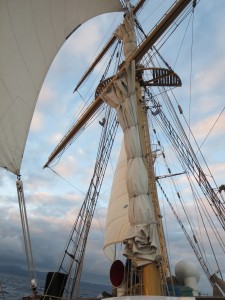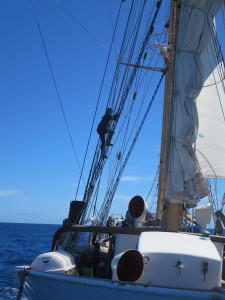Walking through Auckland after leaving the boat, I catch myself constantly reaching forward. As if there will be a brass handrail next to me, to brace myself on. But on land I do not always need to brace myself.
It has only been a few hours, but already it seems impossible that I walked up the ladder to the doghouse at all hours of the day. The brass handrail always there. Gleaming.
– – –
The pro-crew visited us for a night at the Leigh Marine Lab were we were finishing up our coursework. It was bizarre, to have so many of us gathered together in a place solidly grounded. Already, the Seamans and our voyage had drifted far away from the immediacy of the academic crush.
But it was wonderful to see them again. One last game of cards. A chance to pretend to read each others’ fortunes and to quietly commiserate and support each other after the election.
Outside of the lab, the ocean rushes into the rocky cliffs we are perched on. The tang of the sea is strong. I do not remember when the smell of ocean became so normal that I stopped smelling it. But here that I can smell it once again drives home how far and separate I am already from our weeks on the Seamans.
I have yet to be asked too many questions by people at home. Even so, I do not know how I will answer them. I can only know I have brushed something big and important. Pivotal maybe. That some decision, made now and maybe re-made in the future could bring me back. To the waves. To the boat. I hope that, in the mean time, my Minnesotan lakes won’t seem to small.
Our time in Leigh is like a long drawn out goodbye. I can’t quite handle it.
– – –
You call your parents in New Zealand. Your father pauses, and you know he will ask about the boat. And you know you do not have the answers. You are not prepared for the questions. You cannot decide if you want them to come or not. Perhaps they will make it seem all real again, or perhaps they’ll only make it clearer how far away the ship already is.
– – –
This trip has so often been one of surprise and wonder and of equally a test of my endurance, of my spirit, of my confidence.
But did it actually happen? Already my precious bunk seems too far away.
What evidence to I have but for a new vocabulary? A grown sense of self-assurance? An appreciation for situational awareness and the direction of the wind?
They gave me a pin at the end of the academic program. A pin. What the hell am I supposed to do with that?
– – –
In Wellington, when a handful of us reunite, all we talk about is the boat. The games we played, the storms we met, the beaches we sat in the sun on. It’s the ultimate you-had-to-be-there conversation. We’d be the worst company at parties. Talking about things few people have done or seen, using strange vocabulary. We talk fast, the inside jokes flowing one after another.
– – –
On the flight home I watch the new Star Trek movie and start when Captain Kirk tells another character he “has the con.” That’s real ship talk there. And his commands, the talk on the bridge sounds exactly like what you’d hear on my ship. Of course, of course. But I didn’t expect to find it there.
– – –
You see an article about tiny houses online. And spend a long time looking at the pictures of compact kitchens and well designed living spaces. For the first time ever, you can truly picture yourself living in such a small space. You’ve learned how to do that well enough on the Seamans.
– – –
At Thanksgiving, I am asked three times in a row about food on the boat. And about how sea sick I got. These seem like boring questions to me. But perhaps it is because I know what life on the boat was like, and my family does not. Not really.
But of course we ate. And the food was great. Truly, not just because we worked hard. And yes, you eventually got used to the waves.
But what about the other things–no one asks about lines or going aloft. No one asks about swimming. Or volcanoes. Or about all the islands or who I might have met.
Or if I loved it.
They remember the shark, but not the whales.
And maybe it is because I did not tell them enough to begin with. Perhaps the message did not make it across all the branches of my family tree that I would be other places than New Zealand. That I’d be doing more than just sailing and staring at the sea.
I tell them about flying fish and they ask all about their biology and why they fly. I do not have those answers.
– – –
Once, my grandma looked at me. Asked, “would you do it again?”
I said yes.


